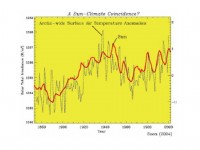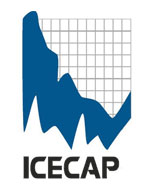Marc Morano, Climate Depot
The new study claims to show “human-generated greenhouse gas emissions have helped reverse a 2,000-year trend of cooling in the Arctic, prompting warmer average temperatures in the past decade that now rank higher than at any time since 1 B.C.,” according to a September 3, 2009 article by the Washington Post’s Juliet Eilperin. The study will appear in the September 3, 2009 online version of the journal Science. The lead author was Northern Arizona University professor Darrell S. Kaufman.
The Washington Post also saw fit to gave prominent play to the environmental group World Wildlife Fund’s new dire Arctic study claiming a scary global warming caused “transformation” of the Arctic. The Post article on the new Arctic “Hockey Stick” completely glossed over years of contrary data and instead mostly gave the authors a scrutiny free ride. (Eilperin also misspelled the name of one scientist she quoted.)
MIT climate scientist Dr. Richard Lindzen told Climate Depot, “This looks like this week’s “Hockey Stick” including many of Mann’s collaborators.” [Editor’s Note: Mann’s has attempted multiple “Hockey Stick” inventions and his newest creation is the Hurricane “Hockey Stick”.]

Ice Mann enlarged here.
Climate data analyst Steve McIntyre who publishes Climate Audit and is known for his research discrediting Mann’s original “Hockey Stick” temperature graph, weighed in on the new Arctic study. “Amusingly, the [Arctic study’s lead author] Kaufman Team perpetuates Mann’s upside down use of the Tiljander proxy,” McIntyre wrote on September 3, 2009. “You can readily see that this closely matches the Mann version,” McIntyre noted. “The most cursory examination [of the study] shows the usual problem of seemingly biased picking of proxies without any attempt to reconcile proxy conflicts,” McIntryre wrote. See also this post showing the cherry picking selection of the proxys with the most hockey stick appearance and other statistical chichanery.
New Peer-Reviewed Study Shows Arctic COOLING Over last 1500 years! - Feb 5, 2008 - Published in Climate Dynamics on 30 January 2008. Excerpt: New Arctic Study published in Climate Dynamics, and the work was conducted by Hakan Grudd of Stockholm University’s Department of Physical Geography and Quaternary Geology - Published online: 30 January 2008 - Excerpt: “The late-twentieth century is not exceptionally warm in the new Tornetrask record: On decadal-to-century timescales, periods around AD 750, 1000, 1400, and 1750 were all equally warm, or warmer.”
Danish Meteorological Institute records show: No Arctic Warming Since 1958! - ‘Arctic was warmer in the 1940s than now’ - May 13, 2009.
U.S. Government Arctic Study: ‘Current rate of human-influenced Arctic warming is comparable to peak natural rates documented by reconstructions of past climates’ - January 16, 2009
January 2008 study in the peer-reviewed journal Science found North Atlantic warming tied to natural variability. Excerpt: A Duke University-led analysis of available records shows that while the North Atlantic Ocean’s surface waters warmed in the 50 years between 1950 and 2000, the change was not uniform. In fact, the sub-polar regions cooled at the same time that subtropical and tropical waters warmed. This striking pattern can be explained largely by the influence of a natural and cyclical wind circulation pattern called the North Atlantic Oscillation (NAO), wrote authors of a study published Thursday, January 3 in Science Express, the online edition of the journal Science. [...] “It is premature to conclusively attribute these regional patterns of heat gain to greenhouse warming,” they wrote.
A November 2007 peer-reviewed study conducted by a team of NASA and university experts found cyclical changes in ocean currents impacting the Arctic. Excerpt: “Our study confirms many changes seen in upper Arctic Ocean circulation in the 1990s were mostly decadal in nature, rather than trends caused by global warming,” said James Morison of the University of Washington’s Polar Science Center Applied Physics Laboratory in Seattle, according to a November 13, 2007 NASA release.
A 2005 peer-reviewed study in Geophysical Research Letters by astrophysicist Dr. Willie Soon, solar irradiance appears to be the key to Arctic temperatures. The study found Arctic temperatures follow the pattern of increasing or decreasing energy received from the sun. Excerpt: Solar forcing explains well over 75% of the variance for the decadally-smoothed Arctic annual-mean or spring SATs (surface air temperatures).

According to a 2003 study by Arctic scientist Igor Polyakov, the warmest period in the Arctic during the 20th Century was the late 1930s through early 1940s. Excerpt: Our results suggest that the decadal AO (Arctic Oscillation) and multidecadal LFO (low-frequency oscillation) drive large amplitude natural variability in the Arctic making detection of possible long-term trends induced by greenhouse gas warming most difficult.
Report: Arctic ‘ice level in the 1920’s, 30’s and early 40’s was at a similar low level’ of today - September 10th, 2008. For many, many more Arctic studies, go to: Climate Depot’s Arctic Fact Sheet - Get the latest peer-reviewed studies and analysis - July 30, 2009
The Post article on the new Arctic study also reported: “The [new Arctic] paper in Science sheds light on several key scientific questions, including how the earth’s orbital pattern around the sun affects our climate, and the extent to which current computer climate models mirror real-world conditions. Some climate skeptics have argued that the fact that the earth wobbles in its axis of rotation has helped determine recent warming, rather than human activities. But the new study shows this wobble—which affects how much sunlight the earth receives in the middle of the summer—actually accounts for a long-term cooling trend in the Arctic, which has only been reversed in the past half-century.”
But geologist Dr. Don J. Easterbrook, Emeritus Professor at Western Washington University, who has authored eight books and 150 journal publications, disputed the findings of new Arctic report. “The glacial record (both advance and retreat history and the isotope data in Greenland ice cores) contrast sharply with the temperature curves shown in this paper,” Easterbrook told Climate Depot. “There is no way that the well documented, short-term climate changes can be orbitally driven because of the vastly longer time scales for orbital changes. Among the big surprises (and most significant) results of the ice core data is that the abrupt, short-term climate changes cannot be possibly be explained by orbital changes,” Easterbrook added.
Singer agreed, noting, “the Abstract tries to relate 20th century temperature changes to insolation changes and claims these are ‘orbitally’ driven. This is highly unlikely: the temperature changes on a time scale of decades; orbital changes are much slower, and generally measured in millennia. I prefer [Harvard University Astrophysicist] Dr. Willie Soon’s analysis of Arctic temperature changes.”
Eilperin then goes on to claim that that the “documentation of the Medieval Warm Period is primarily about Europe, and natural records indicate average Arctic temperatures during that time were not as high. There was a brief period in the early fifth century that came close to, but was not quite as warm, as the Arctic’s most recent summer temperatures.”
How sad, that Eliperin’s refused to do basic research before making such a whopper of a claim. The latest research clearly reveals that the Medieval Warm Period (used to be referred to as the Medieval Climate Optimum) has been verified and was in fact global, not just confined to the Northern Hemisphere. The Center for the Study of Carbon Dioxide and Global Change reported in 2009 that the “Medieval Warm Period was: (1) global in extent, (2) at least as warm as, but likely even warmer than, the Current Warm Period, and (3) of a duration significantly longer than that of the Current Warm Period to date.”
In addition, The Science and Public Policy Institute reported in May 2009: “More than 700 scientists from 400 institutions in 40 countries have contributed peer-reviewed papers providing evidence that the Medieval Warm Period (MWP) was real, global, and warmer than the present. And the numbers grow larger daily.”
After promoting the eco-group World Wildlife Fund’s new climate study, the Washington Post also digs up a scientist with a woeful reputation, Robert Corell, and chooses not to identify his employment with the partisan Heinz Foundation, vice-chaired by Teresa Heinz Kerry, wife of Senator John Kerry (who recently claimed: Global Warming Is The Next 9/11) Eilperin felt compelled to state that Fred Singer was a “skeptic” but the reporter felt no obligation to label any other scientists she cited in the article. Reporter Eilperin wrote: “Robert Correll, who chairs the Arctic Climate Impact Assessment, said the paper in Science will likely ‘in the long haul become a seminal piece in the scientific literature” because it allows other climate researchers “to set their work in a long time scale.’” First off, Eilperin misspelled Corell’s name as “Correll.” Second, Eilperin could not find the space in her article to note Corell’s affiliation with former Vice President Al Gore or his role in the left-wing Heinz Center or the fact that Corell, has been under fire for dubious climate claims. In addition, Corell has been linked to an “affiliate” of a Washington, D.C.-based consulting firm that provides “expert testimony” in trials and he was reportedly sponsored by the left-leaning Packard Foundation. Read much more here.


